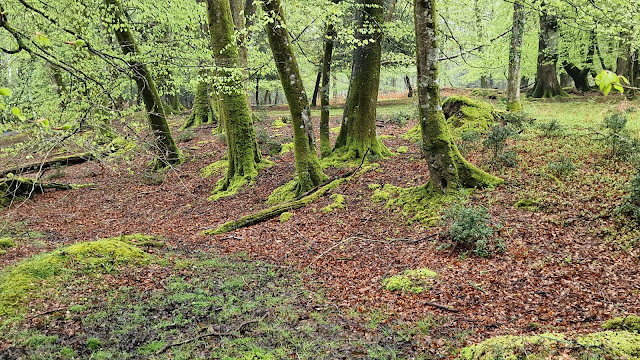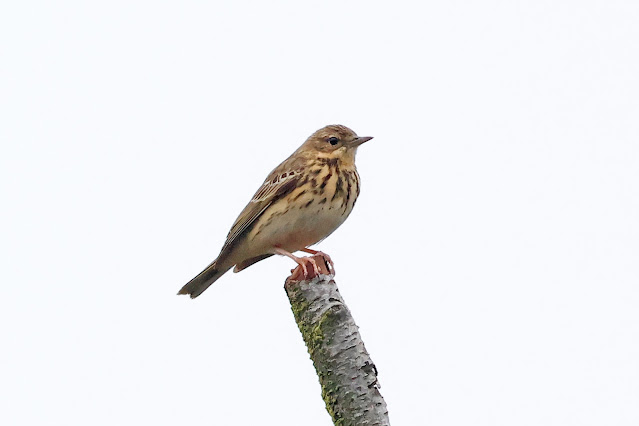Early morning rain delayed me leaving for the Nee Forest this morning, as I headed west there was a mist hanging in the air and as I arrived at the Acres Down car park the visibility was not good. But I wasn't here to watch from the view point I was hoping to find, what is now, a very rare bird in Hampshire, the Wood Warbler. Up to about five years ago you could guarantee you would find several of them around the usual locations, but today they seem to have stopped coming, one last year was a bonus and not the norm.
I set off from the car park, past the woodpecker tree and then turning up the path past the owl tree on the left hand side. After the overnight rain and thunder storms the trees looked dark and contrasted so well with the moss and the newly emerged leaves.
As I reached a junction I could hear both Redstart and Willow Warbler singing. I walked over to a strip of trees, the Redstart continued to sing, but I could not find it. I had better luck with the Willow Warbler as it showed well singing, of course, in a Willow tree.
What was interesting was that at the start of the song it was "chiff" "chiff" "chiff" and then the willow warbler song.
A cuckoo called from within the woods on either side of the path but never showed. There was Blackcap and more Redstarts singing, but not the hoped for Wood Warbler. I passed habitat that looked suitable for Wood Warbler but there was no sign or sound of any.
Coming to terms with the fact that they probably weren't there, I went looking for another heath specialist and found at least three in an open area, with small bushes and a few spindly trees. I picked it up by the song, the Tree Pipit.
I walked across the open heath and was able to get close to the pipit, using the slope to reduce the height of the perches it was using.
I rejoined the path that picked up the track that leads from the car park and walked down to Highland Water. The stream was running fast, but after a short walk around the meanders I found this male Grey Wagtail.
As I walked back to the car I never expected to see my next bird. As I approached the woodpecker tree I suddenly heard drumming, it was fast and light and I knew it had to be the Lesser Spotted Woodpecker. I ran to watch point and sure enough the male Lesser Spotted Woodpecker was in his usual spot and was drumming away.
Had it not managed to find a mate or maybe the nest has failed, to be drumming this late in the year for this woodpecker is unusual.
An appreciation of the woodpecker, "usual" tree.
It then flew off and away over my head and I walked on, passing the roots of these Beech trees covered in moss.
I walked up onto the down in the hope of maybe finding Woodlark, or maybe some more Tree Pipits. All I did manage was a Stonechat and another drumming, this time from a Snipe over the waterlogged heath. This gives you some idea of the poor visibility today.
After lunch in the car park I headed off to somewhere I haven't been to for some time. A standing joke between Ian and myself and I sent him a photograph of my walk as I made my way to the hide, the question was simple, "where am I?" and the answer was Testwood Lakes.
I walked around to the Sand Martin Hide, looking out a Common Tern was fishing over the pool in front of the hide.
At the back of the pool a Great Egret was fishing.
But found itself not welcome by the Lapwing that was standing guard over its mate on the nest.
The egret using the dagger like bill as a means of defence from the dive bombing Lapwing.
The Sand Martin wall was busy with plenty of Sand Martin and they would fly out over the lake. It is always a challenge to photograph the hirundines as they twist and turn and the results were not very good. This Swallow though was dipping into the water and I managed something acceptable.
The egret had managed to get away from the Lapwing.
The main reason for being here was to year tick Little Ringed Plover. The high water levels have made it hard to find them this spring. One was nesting on one of the shingle islands. It was pointed out to me. Can you see it?
Cropping in you can just see the head of the plover on the nest.
One of the Sand Martin over the pools.
The Great Egret was back.
A Muntjac appeared by the side of the Sand Martin wall and was merrily eating the Stinging Nettles.
So the Great Egret was moved on by the Lapwing and decided to try a shallower pool, but it didn't realise that Coot don't like him either. Don't mess with a Coot.
The Common Tern showing well again.
Then some acceptable shots of the Sand Martin.
The artificial nest holes created by concrete and cement, but the Sand Martin are more than happy to use them.
I left the hide, but before I left the reserve, could I get a better view of the Little Ringed Plover. I walked around to the screens and managed to get a slightly better view. Interestingly there was not any sign of the mate.
Shame about the Wood Warbler, but I think we have to accept the status of the Wood Warbler in the New Forest now. Nice to catch up with the Tree Pipit and I enjoyed the afternoon and the challenges in the hide at Testwood!







































No comments:
Post a Comment